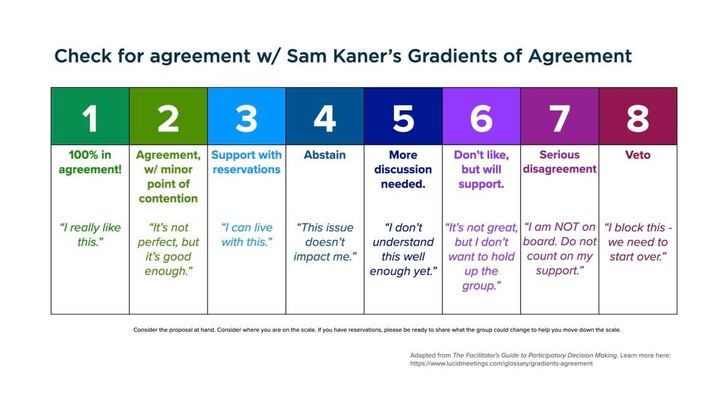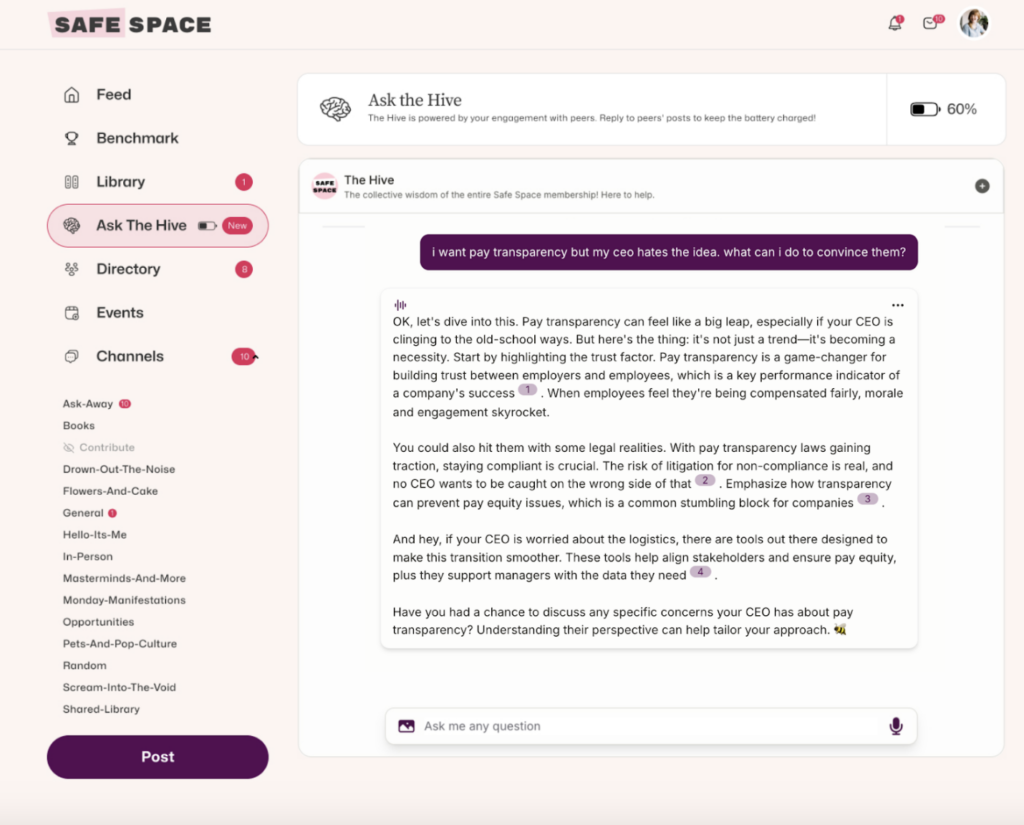✍ How do you effectively and meaningfully support your employees in a down market?
Context: We are a mid-sized company (500+ employees globally). Over the last year we have gone through layoffs, cost cutting measures, etc. and are struggling to find ways to keep our employees motivated and energized. We have some funds for teams and offices for social / meaningful events, we are also asking our team leaders to lean in on mentorship and accelerating the growth and development of their team members, encourage praise for successes, etc. Welcome other avenues to consider!
Not a fun place to be and unfortunately where alot of People leaders are right now. From my experience, I think as much transparency/honesty as possible is the best direction. Your population is unsure about their future with the company and starts them down the path of diminishing efforts. I like the idea of mentorship by leadership but make sure you are supporting them and providing resources, otherwise it’s just one more thing on their plate. Anonymously poll your crew about what they want, start an employee led culture/event planning group; one of the easiest options is to encourage shout-outs/praise from one another, use slack or some other form of communication that is easy and seen by everyone, it goes a long way to healing the culture if you create a culture of mutual respect and kindness. Hope this helps and good luck!
Jessica Winder, Head of Talent at Tailscale:
My two cents:
- Transparent Communication: Keep employees informed about the company’s situation and plans.
- Professional Development Opportunities: Invest in training and development programs to help employees enhance their skills and stay engaged. This could include online courses, workshops, or certifications relevant to their roles.
- Mentorship and Coaching: Encourage team leaders to mentor and coach their team members to support their growth and development. T
- Feedback and Listening Sessions: Create opportunities for employees to provide feedback and share their concerns. Actively listen to their input and appropriately address their needs and concerns.
- Community Engagement: Engage employees in community initiatives or corporate social responsibility activities to give them a sense of purpose and fulfillment beyond their day-to-day work.
- Leadership Visibility and Accessibility: Ensure leadership remains visible and accessible to employees during challenging times. Leaders should demonstrate empathy, provide guidance, and be available to address questions and concerns.
Sondra Norris, Founder of Ultimate Manager Enablement:
Love the suggestions so far!
I’d add the angle of striving to create a level of commitment with the employees that will have them protecting the business during this hard time. And this all about the human relationship, the trust and faith they have in the company, its leaders, and their direct managers. What you are battling in this order, in my opinion:
- Erosion of faith and trust in the company and its leadership
- Uncertainty: will we make it? Should I stay here? Are they listening to us?
- Clarity of business plan
- Career development and mentorship.
And so here are some things, food for thought:
- Make a clear and bold leadership statement of intention. This company is in business to do XYZ. As leaders this company is our vehicle for making the world a better place, starting with all of you and for all of the people depending on you. Include a plain, transparent disclosure about the layoff, about how it may have fractured trust and faith – and how the team wants to ask for and rebuild that trust, little by little. We can’t control everything, but we can control how we will conduct ourselves and our business:
- With respect
- With your contribution
- Supporting one another
- With clear decision making
- … Whatever else is important to the humans who are leaders at your company.
- Adding on to the listening suggestion above: Employees can ALWAYS talk about what things are hindering their effectiveness, are extra spends of money, take too much time – and this is a great way to give proof points about leadership’s intentions (“With your contribution.”). Listen and act – because their input matters and will help the company survive to fight another day.
- I’d recommend AGAINST spending money on social events. They watched their colleagues and friends lose their jobs in the layoff – spending money on activities can send the wrong message.
- I would spend money on managers. Leadership is important – but employees take their most important cues from their managers. Make sure they’re great at consistently providing context; never let them say that “management made a decision, it’s out of my hands;” make sure they understand their own energy levels and how to manage them – low energy managers are at the mercy of their own shadow-sides.
- I would spend money on facilitated problem-solving sessions and assistance on making sure the focus stays on what’s necessary for success. There can’t be a list of 17 priorities right now. There needs to be informed decisions about where we are going to place our bets and why – and when we will decide to pivot – at which specific and verifiable milestones?
- Send letters home. Employees going home and being worried, complaining, etc. – they’re telling their work stories to their families, the ones who are truly important to them … “Why do you stay there?” will get harder and harder to answer. Tell the families about the unique and amazing and important contribution the employee makes every day. Thank them for their patience as the company works through a hard time.
- Abolish the word “resiliency.” That just means keep working harder towards an uncertain future.
- Provide as much certainty and predictability as possible. Even if that’s only a 30-day time horizon. Promise only what’s promise-able. At the end of 30-days, claim leadership credit to start rebuilding trust – REPEAT THIS EVERY 30-DAYS. Your leadership will hate this – because they can’t SEE the difference this makes – but it absolutely makes a difference.

✍ How do you get a team that seems to get on the same page and then once they separate everyone is just going in different directions to ACTUALLY get on the same page and be successful?
Context: Small family-owned + in HVAC. At the beginning of a transition period from owner to son and another employee. Owner has one direction he goes in, son has different thoughts so they agree in the meeting, and I think they have the same goal they just take different approaches and it creates a mess and confusion for the rest of the team.
Jessica Winder, Head of Talent at Tailscale:
Transition periods in family-owned businesses can be tough. Here is what I’ve done in the past in this situation:
- Talk it Out: Encourage honest communication. Make sure everyone feels free to share their thoughts and concerns without fear. A culture of “niceness” could be the root of the problem.
- Know Who Does What: Make sure everyone knows their job (and a high level of what others are meant to be doing as well) and how it fits into the big picture.
- Learn Together: Offer training so everyone can improve their skills.
- Celebrate Wins: Acknowledge and celebrate when the team succeeds. It boosts morale and keeps people motivated.
- Get Help if Needed: Consider getting advice from outside experts if things are tough. Having a coach for the executive team is pricey but helpful.
Lisa Van Lenner, VP of Operations, People & Culture at Mythical:
I think this is where Hebba’s last newsletter about goals and OKRs can really help. Everyone might have the same “goal” but when it lacks flexibility in how to achieve it, it can appear that everyone is going in a different direction.
JOIN 150K+ HR LEADERS
Get insights, learnings, and advice on how to build companies and cultures that people actually love.
No spam. Unsubscribe any time.
OKRs allow the leader (maybe the current owner) to set an Objective (hopefully agreed upon by the son & partner) and let the son/partner and other leads interpret how to reach that objective through Key Results. Having different approaches to the same goal might not be the worst thing if everyone knows they are all held accountable to the same result metrics.
Kendra Silvestri, Director of Operations at FreshCut Paper:
This is going to sound simple but it often gets missed – the decisions made in the meeting should be documented and shared. We document and share the decisions and the action items after each meeting, including who is responsible for each item and when it is due. Anything larger than a quick task should be added to our project management tool and assigned a priority level.
Whenever we have failed to do this, the team walks out of the meeting with different interpretations of the discussion and that is when we end up going in different directions. This happens even when we felt that we were all aligned in the meeting which is why it is so important to document and share it after the meeting.
Patricia Wortham, CHRO at GridStor:
I agree with the above comments and would recommend using the gradient of agreement and RACI matrix when dealing with decisions and responsibilities.




